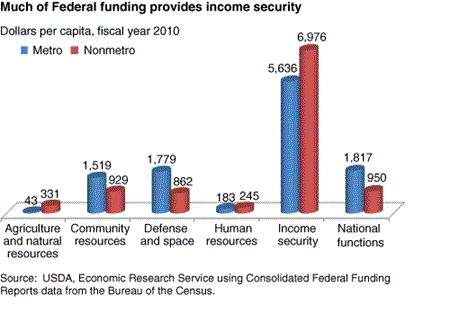Potential Rural Implications of Federal Budget Pressures

In the coming years, anticipated deficit reduction legislation could affect rural America. It is too early to know with any certainty which Federal programs will be affected, or by how much, but the current composition of rural Federal funding receipts can reveal insights about rural America's potential vulnerability to budget cuts.
Analysis of fiscal year 2010 data, the latest available from the Consolidated Federal Funds Reports assembled by the U.S. Bureau of the Census, indicates that rural (nonmetro) areas receive almost as much total Federal funding, per capita, as urban areas: $10,293 versus $10,976. These funding levels exclude programs that are not tracked to the local level. For example, community development block grants and several large human resources programs are excluded for lack of local data. Of the program funding that can be tracked to the local level, income security programs (Social Security, Medicare and Medicaid, low-income housing payments, unemployment, and other forms of public assistance, including some large USDA programs such as the Supplemental Nutrition Assistance Program) account for two-thirds of all Federal funding in rural areas. In contrast, urban areas receive just over half of their Federal funding in this category. Consequently, rural areas might be particularly affected by cuts in income security programs.
After income security programs, rural funding levels (per capita) are greatest for national functions (including energy, higher education, and law enforcement), community resources, and defense and space programs. Of these three categories, community resources programs, which include infrastructure, business assistance, housing, and other development-related programs, may be particularly important for addressing economically depressed conditions.
Rural areas receive considerably less of their funding from human resources programs (covering education, training, nutrition, health, and social services) and from agriculture and natural resources programs. However, in each of these broad groups of programs they receive more, per capita, than urban areas. Some rural places may be particularly affected by changes in funding levels for these programs. For example, agricultural programs accounted for 16 percent of fiscal year 2010 Federal funds flowing to a group of 403 farming-dependent nonmetro counties, mostly located in the Midwest. Only income security programs accounted for a larger share of Federal payments for these areas.
While aggregate funding levels may provide a broad measure of rural America's use of Federal programs, it is important to remember that program effects are likely to vary depending on the type of assistance. Grants, loans, direct payments to individuals, procurement, and Federal salary payments are all aggregated together in the statistics presented here, even though they can have very different local economic impacts. Thus, the ultimate impact of changes in Federal program funding from a local area's perspective depends on adjustments in funding levels for particular programs.
Federal Funds, USDA, Economic Research Service, January 2021


